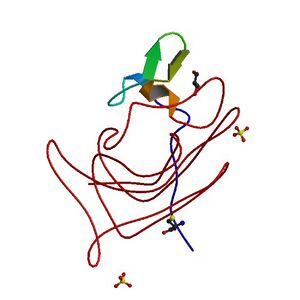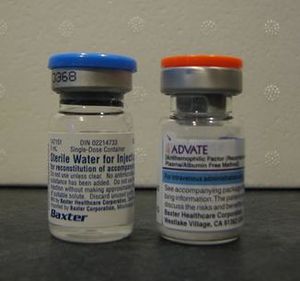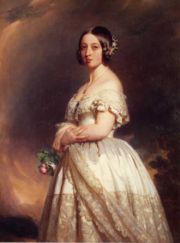نزيف الدم الوراثي
| Haemophilia | |
|---|---|
| الأسماء الأخرى | Hemophilia |
 | |
| A drawing of clotting factor VIII | |
| النطق | |
| التخصص | Haematology |
| الأعراض | Easy and prolonged bleeding[1] |
| البداية المعتادة | At birth[2] |
| المسببات | Usually genetic[3] |
| الطريقة التشخيصية | Blood test[4] |
| الوقاية | Preimplantation screening[4] |
| العلاج | Replace missing blood clotting factors[3] |
| التردد | 1 in 7,500 males (haemophilia A), 1 in 40,000 males (haemophilia B)[2][5] |
نزف الدم الوراثي (هيموفيليا Haemophilia) هو الاسم الذي يٌطلق على أي من الامراض الوراثية المتعددة التي تسبب خلل في الجسم وتمنعه من السيطرة على عملية نزف الدم. ان الاسباب الوراثية ( او نادرا ، اسباب في المناعة الذاتية للجسم) تسبب نقص في عوامل التخثر للبلازما الذي يعمل على تسوية عملية تخثر الدم ، عندما يصاب وعاء دموي بجرح لن تتكون خثرة ويستمر الدم بالتدفق لمدة طويلة من الزمن. ممكن ان يكون النزف خارجي ، كالجلد اذا تم حكه بشيء او عندما يٌصاب بقطع ، ايضاً ممكن ان يكون النزيف داخلياً مثلاُ في العضلات او المفاصل او الاعضاء المجوفة . اما ان يكون النزيف ظاهراً أي في الكدمات التي على الجلد ، أو نزيف داخلي كنزيف الامعاء أو النزيف الدماغي.
تاريخ
يسمى نزف الدم الوراثي بـ"المرض الملكي" لانه كان سائد عند عوائل الأٌسر الحاكمة . الملكة فكتوريا نقلت هذا إلى ابنها و عن طريق بناتها انتقل هذا المرض إلى العوائل الحاكمة عبر القارات ، ومنهم الأٌسر الحاكمة في إسبانيا وألمانيا وروسيا.
أنواع مرض نزف الدم
مرض فون ويليبراند نوع 1 و 2 هما اقل خطورة من الانواع الثلاثة للهيموفيليا أعلاه. فقط نوع 3 من مرض فون ويليبراند يكون شديد كالهيموفيليا . مرض فون ويليبراند (vWD) يحصل بسبب طفرات وراثية في بروتين التخثر عامل فون ويليبراند. وهو اكثر مرض تخثر موجود في الناس ، حيث أن 1% من البشر مصابين به .
العلامات والأعراض
المضاعفات
جينات
يوجد لدى الاناث كروموسومين X بينما لدى الذكور كروموسوم Y و اخر X . بما ان عوامل الطفرة المسببة للمرض هي متنحية ، تحمل الانثى المرض على كروموسوم X و لا تكون مٌتأثرة به لان الكروموسوم الاخر الذي هو X ايضاً سيعمل على توليد عوامل التخثر . بما ان الذكر سيستقبل ال X من امه فهناك احتمال ان تكون نسبة وراثته المرض من امه الغير مصابة بالمرض لكن حاملة له هي 50% ، واما اذا كانت امه مصابة ايضاً بالمرض فستكون احتمالية اصابته بالمرض 100% . اما الاناث فيأخذون زوج X واحدة من الام والاخرى من الاب ( حيث يجب أن يكون الاب مصاب حتى تكون الانثى حاملة " او مصابة اذا كان الاب مصاب والام حاملة او مصابة") غيرها سيكون الاحتمال بعيد ان تصاب الاناث بهذا المرض ، لهذا ان نسبة الذكور الذين يصابون به اعلى.
الشدة
التشخيص
الادارة
لايوجد هناك علاج تام لهذا المرض. ولكن العلاج ومنع النزف يكون بأخذ حٌقَن منظـِّمة لتسد نقص عامل التخثر مثلاً عامل 8 في هيموفيليا A و قلة عامل 9 في هيموفيليا B. لكن قد يقوم الجسم بتكوين اجسام مضادة ضد الدواء المٌعطى ، لذلك اما ان يتم زيادة الجرعة أو اعطاء مواد غير مأخوذة من مصادر بشرية.[3]
عوامل التخثر

Clotting factors are usually not needed in mild haemophilia.[6] In moderate haemophilia clotting factors are typically only needed when bleeding occurs or to prevent bleeding with certain events.[6] In severe haemophilia preventive use is often recommended two or three times a week and may continue for life.[6] Rapid treatment of bleeding episodes decreases damage to the body.[6]
غيرهم
Desmopressin (DDAVP) may be used in those with mild haemophilia A.[6] Tranexamic acid or epsilon aminocaproic acid may be given along with clotting factors to prevent breakdown of clots.[6]
التاريخ
John C. Otto, 1803[7]
الاكتشاف العلمي
The first medical professional to describe the disease was Abulcasis. In the tenth century he described families whose males died of bleeding after only minor traumas.[8] While many other such descriptive and practical references to the disease appear throughout historical writings, scientific analysis did not begin until the start of the nineteenth century.
In 1803, John Conrad Otto, a Philadelphian physician, wrote an account about "a hemorrhagic disposition existing in certain families" in which he called the affected males "bleeders".[9] He recognised that the disorder was hereditary and that it affected mostly males and was passed down by healthy females. His paper was the second paper to describe important characteristics of an X-linked genetic disorder (the first paper being a description of colour blindness by John Dalton who studied his own family). Otto was able to trace the disease back to a woman who settled near Plymouth, NH in 1720. The idea that affected males could pass the trait onto their unaffected daughters was not described until 1813 when John F. Hay, published an account in The New England Journal of Medicine.[10][11]
In 1924, a Finnish doctor discovered a hereditary bleeding disorder similar to haemophilia localised in the Åland Islands, southwest of Finland.[12] This bleeding disorder is called "Von Willebrand Disease".
The term "haemophilia" is derived from the term "haemorrhaphilia" which was used in a description of the condition written by Friedrich Hopff in 1828, while he was a student at the University of Zurich.[9][13] In 1937, Patek and Taylor, two doctors from Harvard, discovered anti-haemophilic globulin.[14] In 1947, Pavlosky, a doctor from Buenos Aires, found haemophilia A and haemophilia B to be separate diseases by doing a lab test. This test was done by transferring the blood of one haemophiliac to another haemophiliac. The fact that this corrected the clotting problem showed that there was more than one form of haemophilia.
العائلات الملكية الأوروپية

المعالجة
تلوث الدم

المراجع
- ^ خطأ استشهاد: وسم
<ref>غير صحيح؛ لا نص تم توفيره للمراجع المسماةNIH2013Sym - ^ أ ب خطأ استشهاد: وسم
<ref>غير صحيح؛ لا نص تم توفيره للمراجع المسماةNIH2013What - ^ أ ب ت خطأ استشهاد: وسم
<ref>غير صحيح؛ لا نص تم توفيره للمراجع المسماةCDC2014 - ^ أ ب خطأ استشهاد: وسم
<ref>غير صحيح؛ لا نص تم توفيره للمراجع المسماةNIH213Diag - ^ خطأ استشهاد: وسم
<ref>غير صحيح؛ لا نص تم توفيره للمراجع المسماةWyn2009 - ^ أ ب ت ث ج ح خطأ استشهاد: وسم
<ref>غير صحيح؛ لا نص تم توفيره للمراجع المسماةNIH2013Tx - ^ "Otto JC. The Medical Repository. 1803; Vol VI (1): 1-4". Genmedhist.info. Archived from the original on 2014-09-04. Retrieved 2013-11-21.
{{cite web}}: Unknown parameter|deadurl=ignored (|url-status=suggested) (help) - ^ "Case of the Week 175". University of Utah Medical Library. Archived from the original on 19 May 2011.
- ^ أ ب Nilsson IM (1994). "Haemophilia—then and now". Sydsvenska Medicinhistoriska Sallskapets Arsskrift. 31: 33–52. PMID 11640407.
- ^ DIGITISED EARLY PAPERS AND BOOKS ON HUMAN AND MEDICAL GENETICS Archived 2011-07-21 at the Wayback Machine Genetics and Medicine Historical Network, Cardiff University.
- ^ Hay J (July 1813). "Account of a remarkable hæmorrhagic disposition, existing in many individuals of the same family". N Engl J Med Surg. 2 (3): 221–5. doi:10.1056/NEJM181307010020302.
- ^ "Haemophilia Special Issue: von Willebrand's Disease: a Report from a Meeting in the Åland Islands". Haemophilia. 18. 2012. doi:10.1111/hae.2012.18.issue-s6.
- ^ "The History of hemophilia". Archived from the original on 31 March 2009. Retrieved 5 June 2009.
{{cite web}}: Unknown parameter|deadurl=ignored (|url-status=suggested) (help) - ^ Chapter 38 Coagulation Factors V and VIII by GC White and GE Gilbert Archived 2017-09-11 at the Wayback Machine in Blood: principles and practice of hematology: 2nd edition. 2003. Eds. Robert I. Handin, Samuel E. Lux, Thomas P. Stossel. ISBN 978-0-7817-1993-3.
وصلات خارجية
| Classification | |
|---|---|
| External resources |

